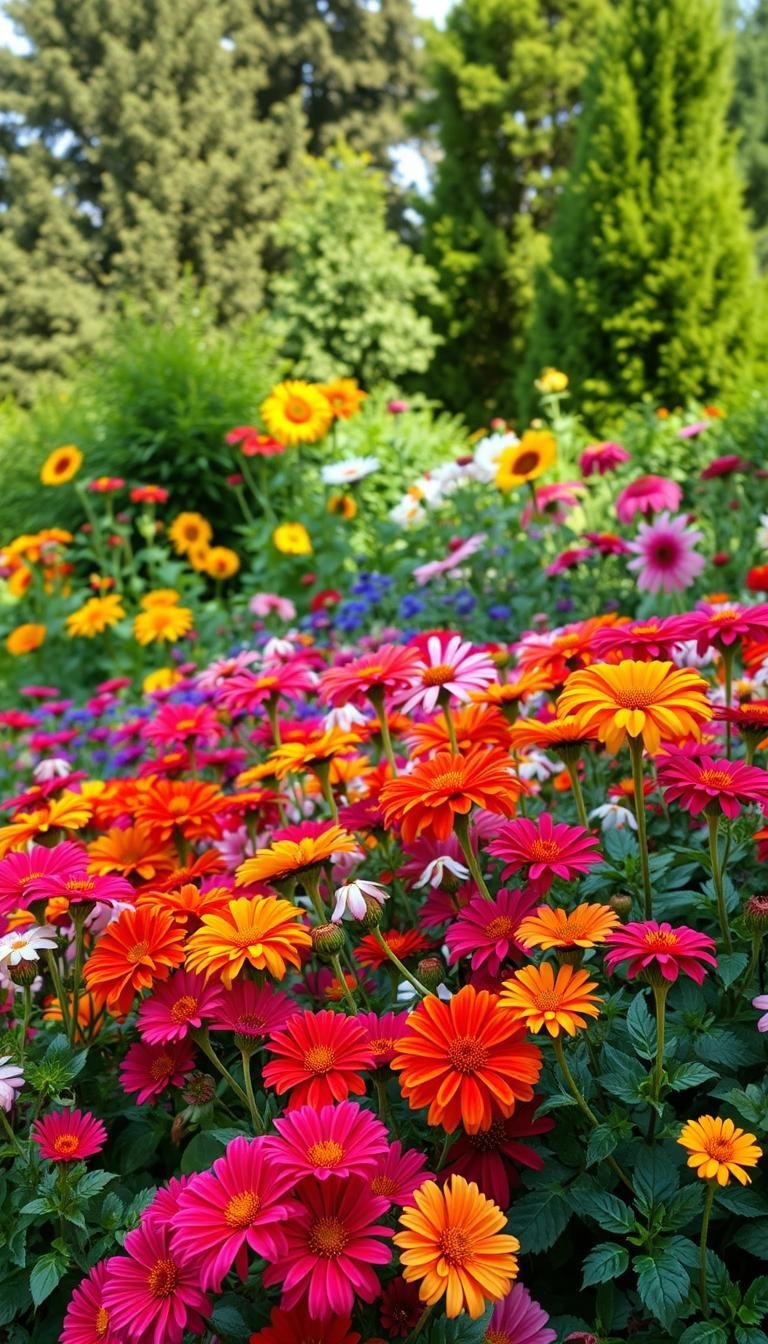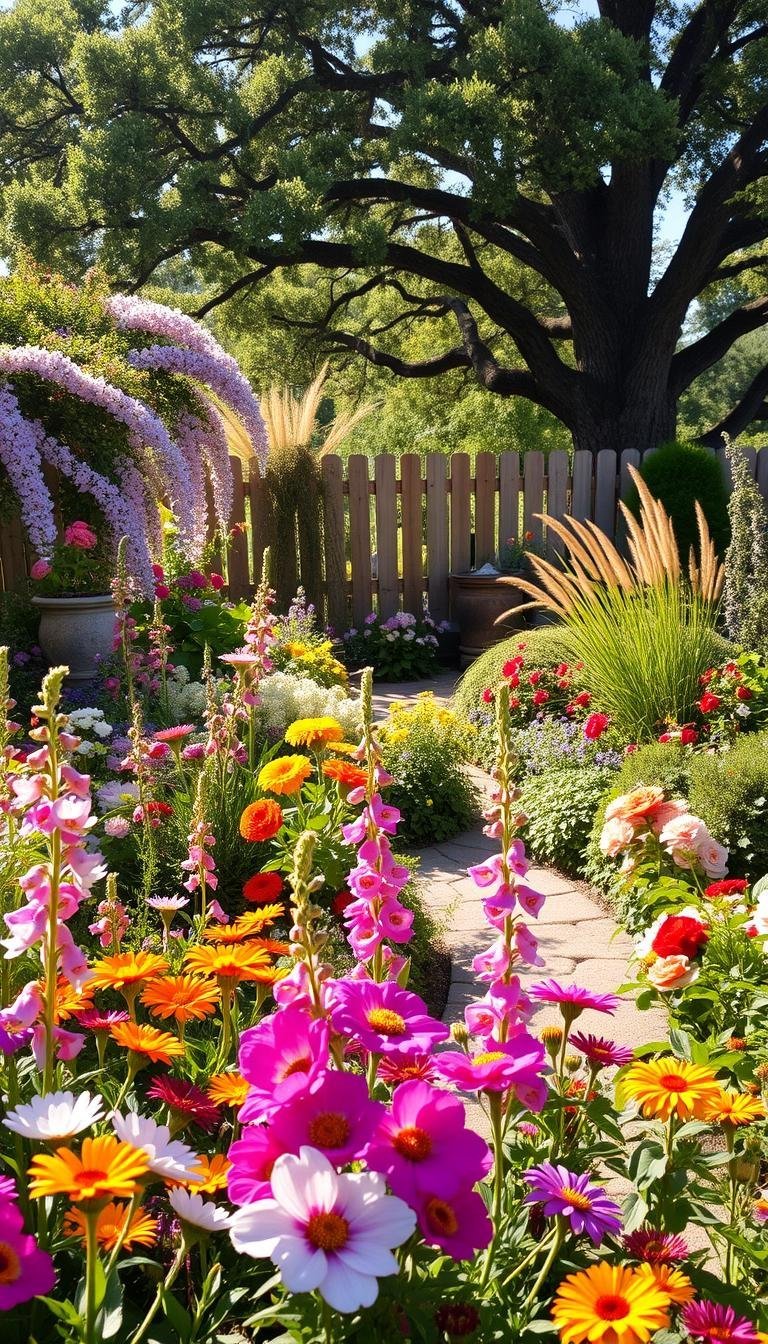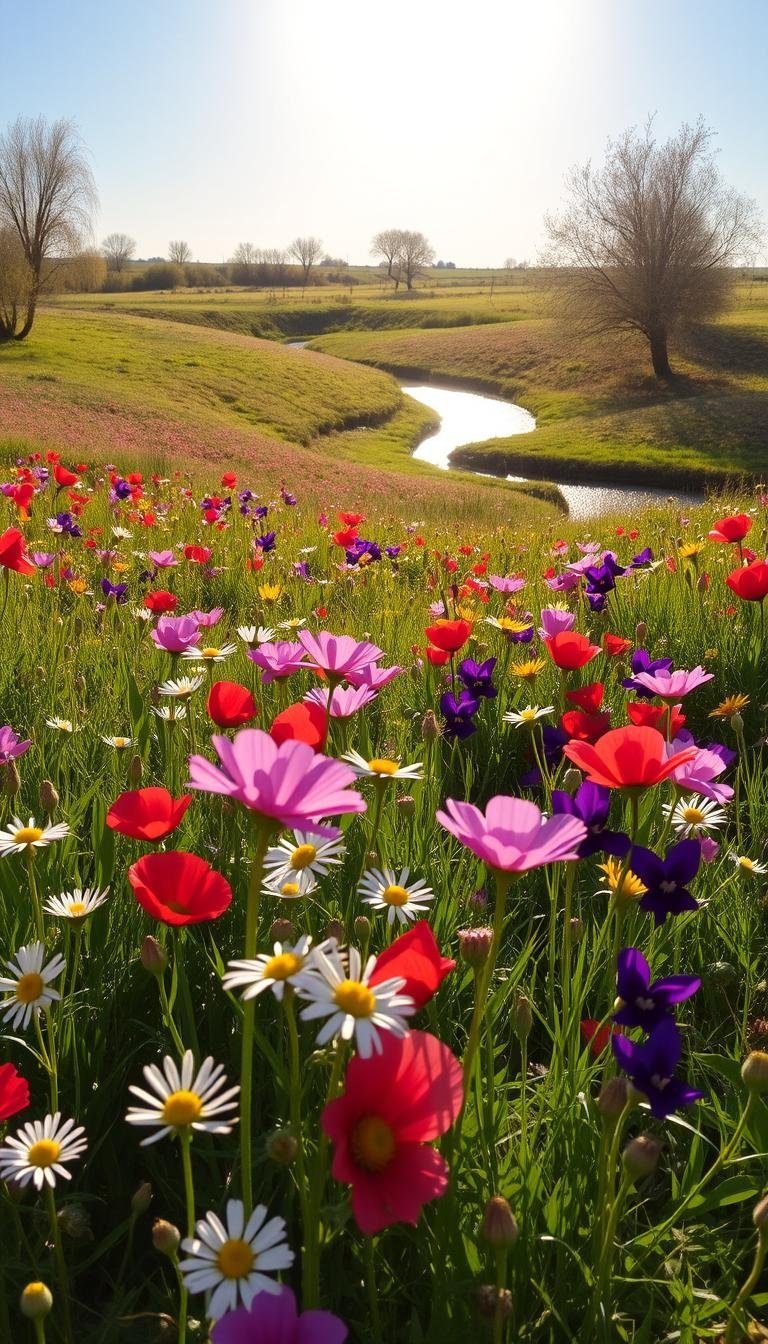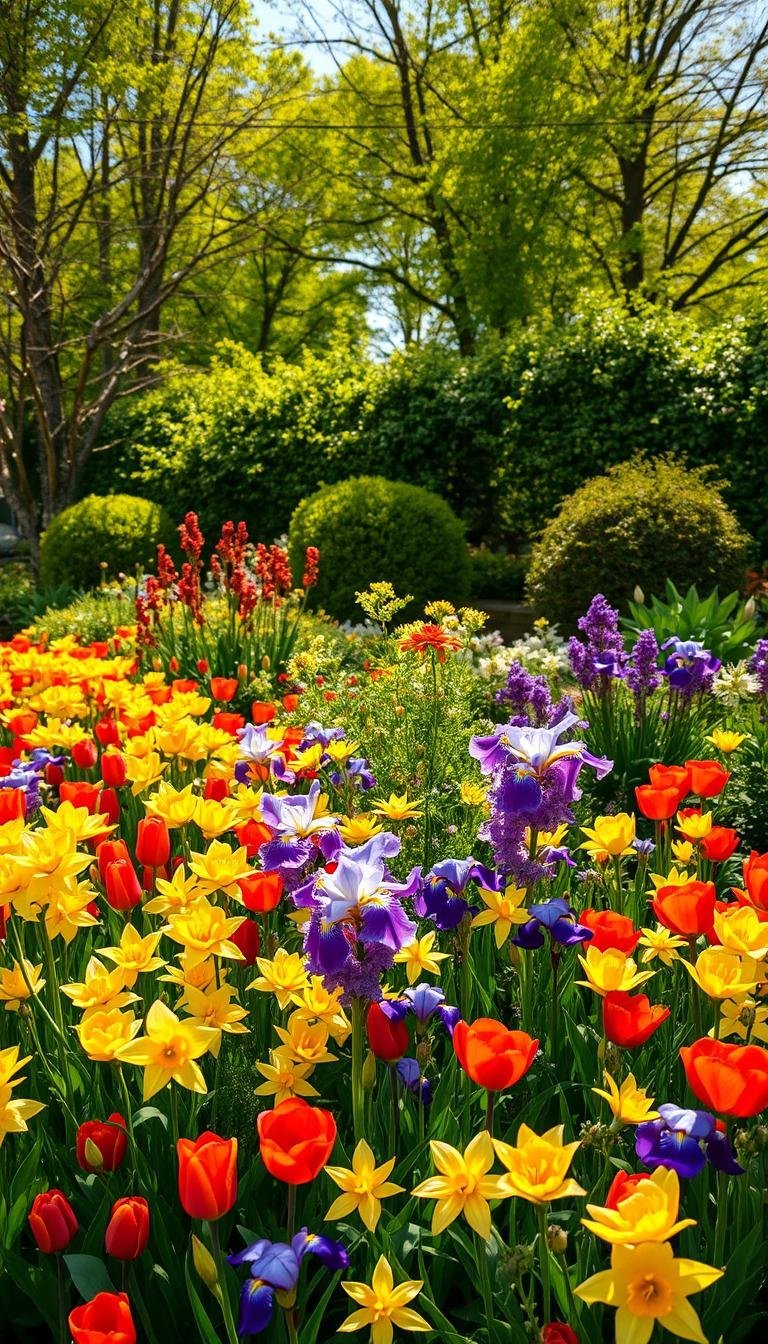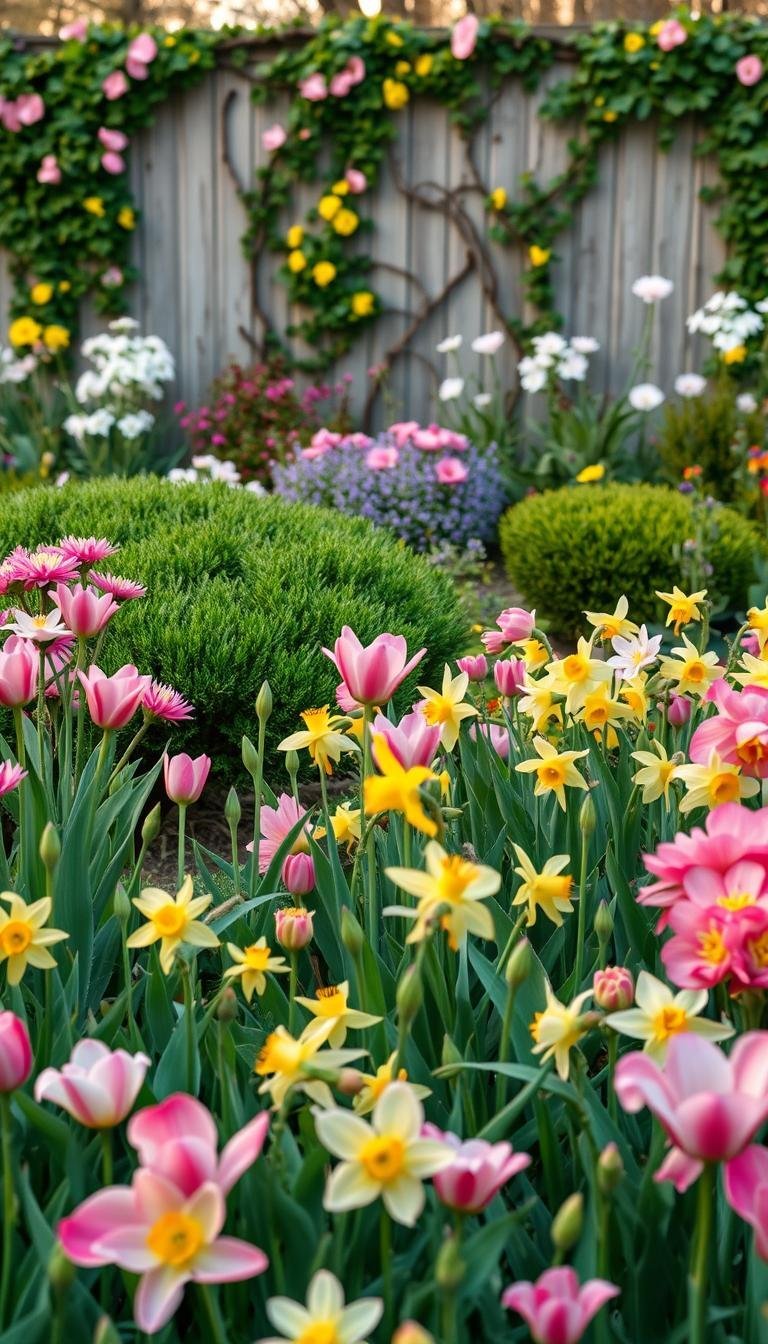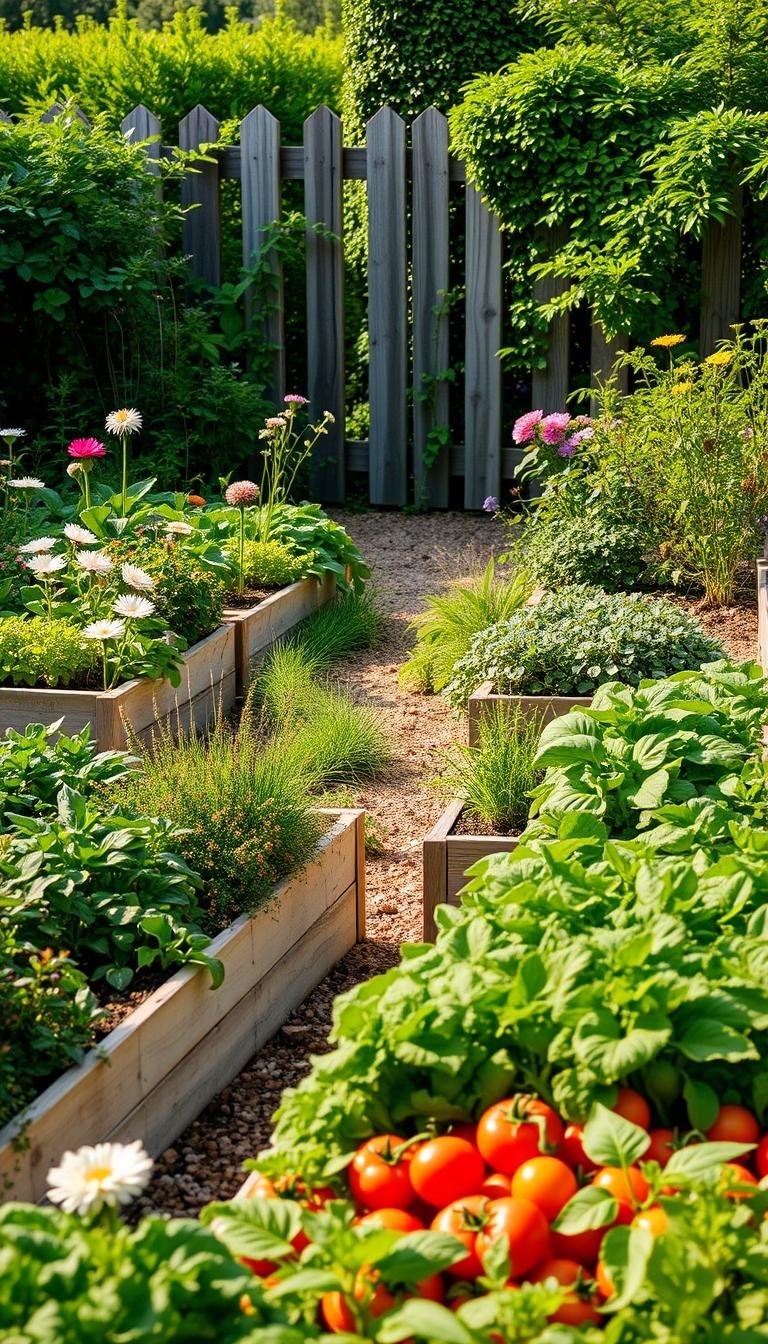This post may contain affiliate links. If you click and buy, we may earn a small commission at no extra cost to you. Learn more.
Summer is the perfect time to make your outdoor space come alive. Plants like sunflowers, zinnias, and marigolds can turn small areas into stunning displays. They love the warm weather, making your patios, borders, and containers look amazing.
Creating beautiful flower beds with seasonal blooms can make your space welcoming. It can also lift your mood and attract wildlife. This guide will show you how to design dazzling displays that boost your home’s appeal. You’ll learn about easy-to-grow plants and get tips for a garden that’s beautiful and easy to care for.
Contents
- 1 The Best Summer Flowers for Your Garden
- 2 Tips for Planting Summer Flowers
- 3 Creating a Colorful Flower Garden
- 4 Maintaining Your Summer Flower Garden
- 5 Attracting Pollinators to Your Garden
- 6 Understanding Summer Flower Care
- 7 Designing a Summer Flower Bed
- 8 Incorporating Edible Flowers
- 9 Seasonal Blooms to Extend Your Gardening
- 10 Resources for Flower Garden Enthuisiasts
The Best Summer Flowers for Your Garden
Choosing the right flowers keeps your garden colorful all summer. Whether it’s your first time or a refresh, knowing annuals and perennials is key. Let’s explore the options to make your choice easier.
Annuals vs. Perennials: What to Choose
Annuals bloom all summer but need replanting every year. They’re great for quick color. Perennials take time to grow but come back year after year, saving you effort. Pick based on your schedule and budget.
- Annuals: Zinnias, marigolds (low maintenance, bright blooms)
- Perennials: Coneflowers, black-eyed Susans (hardy, reliable in perennial flowers garden)

Top 5 Must-Have Summer Blooms
- Zinnias: Bright hues, thrive in full sun, easy to grow from seed.
- Sunflowers: Tall and striking; attract pollinators to your blooming flowers garden.
- Coneflowers: Drought-tolerant perennials with purple petals.
- Petunias: Continuous blooms in containers or beds.
- Salvia: Spiky flowers in red or blue; attracts hummingbirds.
Combine annuals and perennials for instant color and lasting beauty. These choices will keep your Summer Flowers Garden lively from June to August.
Tips for Planting Summer Flowers
Starting a Summer Flowers Garden is all about smart planting. Whether you’re new or have lots of experience, these tips will help your flowers bloom fully.
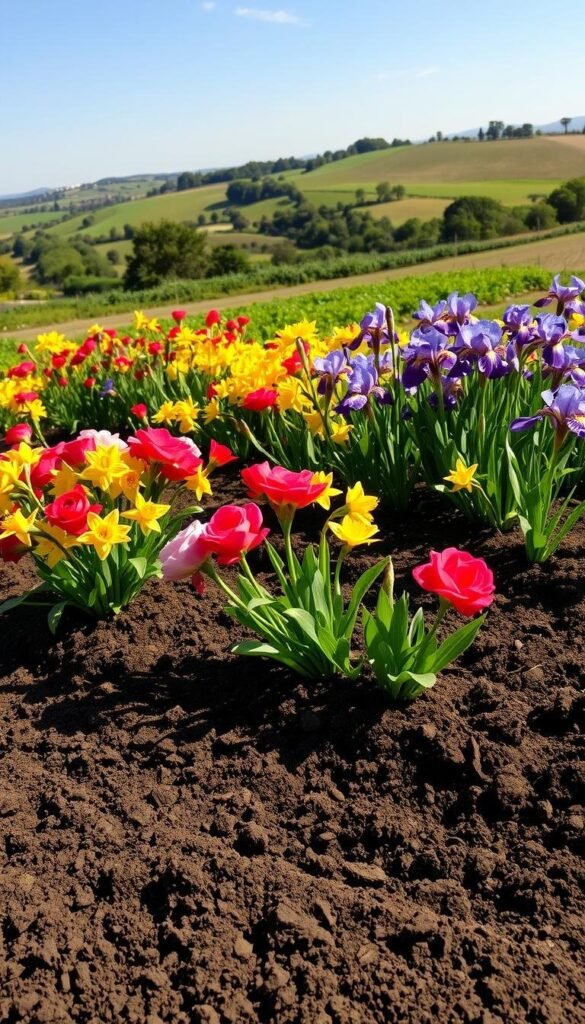
Soil Preparation Techniques
Good soil is key for a lively garden. First, test your soil’s pH and nutrient levels. Add compost or aged manure to make poor soil better. Mix in sand to help water drain in clay soils.
For tight soil, till in peat moss to improve air. A well-prepared bed lets roots get water and nutrients easily.
“Healthy soil grows healthy flowers. Prioritize preparation over perfection.” – National Gardening Association
Best Planting Times
When you plant matters a lot. Plant sensitive annuals like marigolds after the last frost. Here’s a simple guide:
- Check USDA hardiness zones to schedule planting dates
- Wait until soil temperatures reach 60°F for most summer blooms
- Space plantings every 2-3 weeks for flower garden ideas that bloom continuously
Use local frost dates (check the USDA Plant Hardiness Zone Map) and plan ahead. This way, your gardening with summer flowers will bring color all season.
Creating a Colorful Flower Garden
Turn your outdoor area into a lively work of art with color theory and smart plant pairings. Colorful summer blooms look best when placed with care. Begin by picking a color scheme that leads the eye and sets the mood.
Color Theory in Landscaping
Match opposites like red and green or blue and orange for striking contrast. Use soft colors like yellows, oranges, and reds to bring peace. Monochromatic schemes with different shades of one color add depth without being too much.
Warm colors like orange and red make small spaces lively. Cool colors like blue and white make areas feel bigger.
Flower Combinations for Maximum Impact
Try these flower garden ideas for stunning displays:
- Sunset Garden: Marigolds (orange) + Russian sage (purple) + pink petunias
- Moonlit Beds: White phlox + silver-leafed dusty miller + blue lobelia
- Monarch Attraction: Butterfly weed (orange) + purple coneflower + burgundy salvia
“Layer tall plants like sunflowers behind shorter ones for lively beautiful flower beds,” says landscape designer Maria Torres. “Mix bloom times so color stays consistent all season.”
Test out plant combinations in pots before planting them for good. Let color lead your design, whether you want a calm spot or a bold statement. Your garden will flourish with careful planning.
Maintaining Your Summer Flower Garden
Keeping your Summer Flowers Garden healthy means plants do well in the sun. Good care keeps flowers bright and handles seasonal issues. Here are key steps for lasting beauty.
“A well-watered garden grows roots; a well-fed garden reaches for the sky.”
Watering Techniques for Hot Weather
Change how you water based on your gardening with summer flowers goals. Try these methods:
- Drip irrigation: It waters slowly and directly, cutting down on evaporation.
- Soaker hoses: Great for big areas, they water the soil right.
- Early morning hand watering: It avoids evaporation and disease risks at night.
Watch for wilted leaves to know when to water. Act fast to prevent damage.
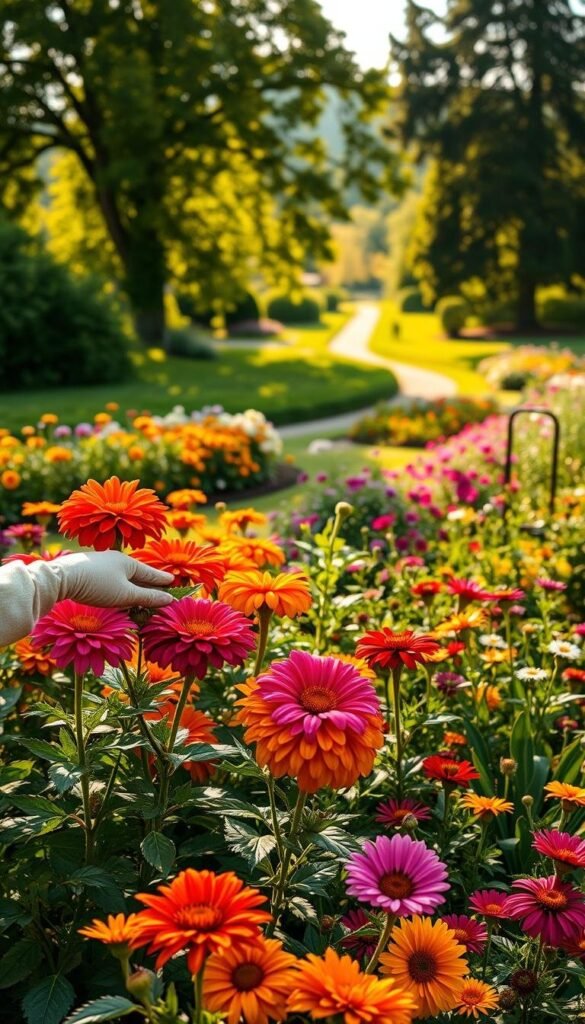
Fertilization Tips for Healthy Growth
Boost your blooms with the right food. Follow these steps:
- Choose plant diversity in summer garden fertilizers with more phosphorus for flowers.
- Give balanced liquid feed every 4-6 weeks when plants grow fast.
- Slow-release pellets are good for steady food without harming roots.
Organic choices like compost tea or bone meal are great for soil. Always check labels to avoid too much fertilizer.
Keeping your Summer Flowers Garden healthy is simple—just keep it up. Mix good water with rich soil for color all season. Plants like marigolds and zinnias will thank you with more blooms. Tailor your care to your garden’s needs, and watch your garden flourish.
Attracting Pollinators to Your Garden
Gardens full of flowers are not just pretty—they’re also homes for bees, butterflies, and other pollinators. By planting many different types of flowers, you help these insects and make your garden more productive. Each flower visit by a pollinator helps grow fruits, seeds, and more flowers next year.
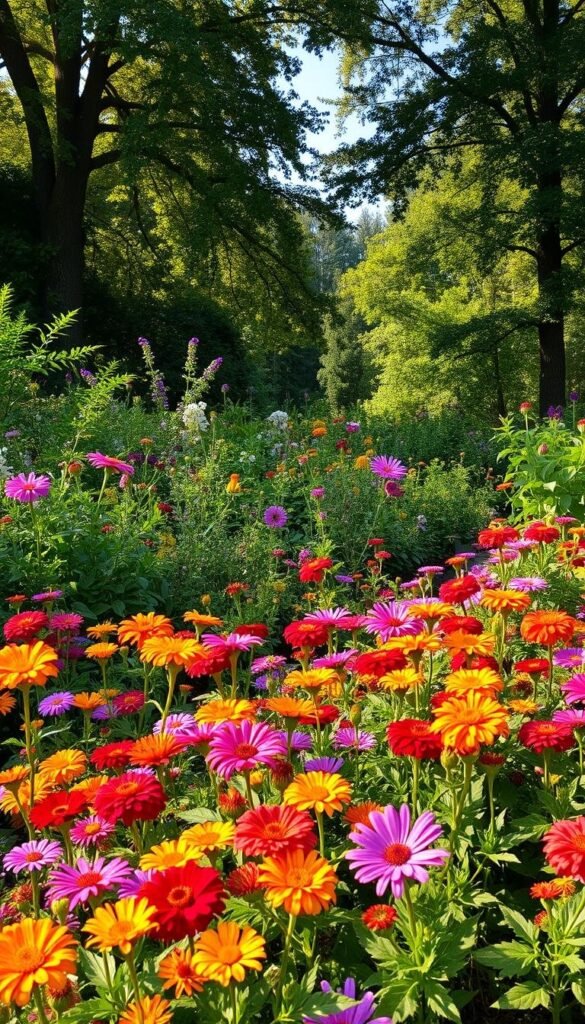
The Importance of Bees and Butterflies
Bees and butterflies are key to plants making seeds. Without them, many flowers wouldn’t grow. But, by planting flowers that attract them, you can help. Flowers like coneflowers and lavender give them food. Also, providing shelter and water helps them stay longer.
Best Flowers to Attract Pollinators
- Bees: Sunflowers, salvia, and clover are great. They have lots of pollen.
- Butterflies: Milkweed and phlox attract monarchs and swallowtails with their nectar.
- Hummingbirds: Trumpet vines and bee balm are perfect for their long beaks.
Make your garden diverse by planting native and exotic flowers. Choose ones that bloom at different times for constant food. Don’t use pesticides. Instead, attract natural helpers like ladybugs. Add shallow water and mud puddles for their hydration and minerals. Your garden will become a haven for life, and it will look beautiful too.
Understanding Summer Flower Care
Learning to care for gardening with summer flowers is key. It helps plants grow well during the hottest months. Here are some important steps to keep your garden looking great.
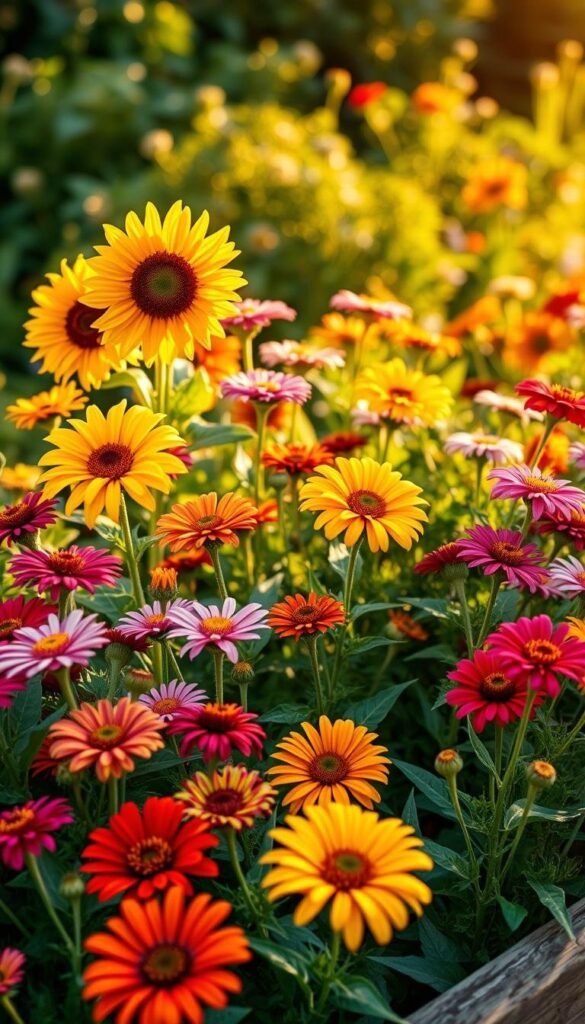
Pruning and Deadheading Essentials
Pruning is vital for plant health. It boosts growth and keeps plants looking good. Here’s how to do it right:
- Trim off old blooms on perennial flowers garden plants like roses or coneflowers with clean shears.
- Cut stems just above a leaf node to help new shoots grow up.
- Shorten long stems on annuals like petunias to keep them bushy.
Deadhead every week to keep flowers blooming longer and prevent seeds.
Pests and Diseases to Watch For
Keep your Summer Flowers Garden safe from pests and diseases with these tips:
- Aphids: Use insecticidal soap or introduce ladybugs to control them.
- Powdery mildew: Make sure plants have enough space for air and use sulfur-based fungicides if it shows up.
- Japanese beetles: Pick them off by hand or spray with neem oil at the first sign.
Know the pests in your area. Southern gardens might face spider mites, while northern ones deal with slugs. Adjust your care as the climate changes.
Designing a Summer Flower Bed
Turn small areas into beautiful flower beds with clever summer garden design. Urban and suburban gardens flourish with creativity and practicality. First, map your space, noting sunlight and paths. Every inch is precious—here’s how to use it well.
Layout Ideas for Small Gardens
Start with a central feature, like a birdbath or statue, to ground small spaces. Use shapes like rectangles or circles to add order. Try these flower garden ideas:
- Border gardens: Edge paths with low marigolds and trailing verbena
- Layered beds: Place tall plants (like hollyhocks) at the back, zinnias in the middle, and creeping alyssum at the front
- Seasonal transitions: Mix June-blooming salvias with late-summer asters for ongoing color
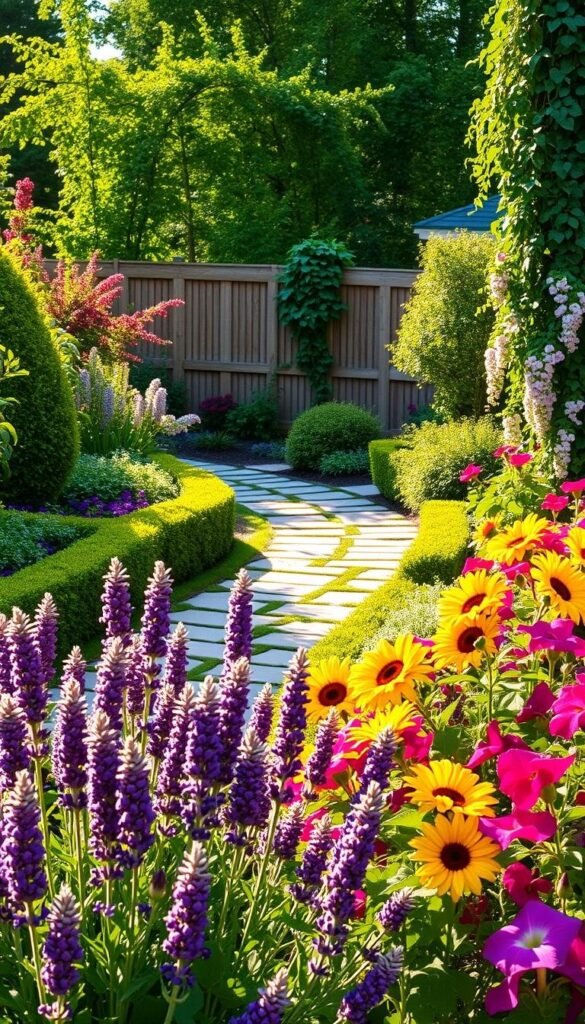
Vertical Gardening for Limited Spaces
Grow upwards with trellises, wall planters, and hanging baskets. These methods are perfect for small areas:
- Obelisks and teepees: Train clematis or morning glories vertically
- Wall pockets: Fill with trailing petunias or sweet alyssum
- Window boxes: Use trailing lobelia and upright geraniums for vibrant displays
“Vertical gardening turns walls into canvases. Use plants with contrasting textures for instant drama.” – Green Thumb Magazine
Combine these ideas to make beautiful flower beds that are full but not crowded. Even small plots, like 4×4 feet, can be stunning with the right plan.
Incorporating Edible Flowers
Turn your garden into a feast with edible blooms. These colorful summer blooms bring vibrant flower garden ideas and tasty treats. Pick flowers at their best for the most flavor and safety.
Flavorful Blooms to Grow This Summer
Here are six edible flowers to try, each with its own taste and care tips:
- Nasturtiums: They have a peppery taste. Use the petals and leaves. Make sure to rinse them before eating.
- Pansies: They taste mildly sweet. You can eat the whole flower. They’re perfect for salads or desserts.
- Bee Balm: It tastes like citrus and mint. Only use the flowers. Be careful not to confuse it with other mint plants.
- Daylilies: They have a sweet taste. Only the petals are safe to eat. Choose non-hybrid varieties.
- Calendula: It has a slightly bitter taste. Use the petals for teas or garnishes. Dry them for winter use.
- Lavender: It has a floral aroma. Use the flower tops. If you’re allergic to mint, be careful.
Culinary Uses for Your Garden’s Flowers
Here are some ideas to get you started:
- Infuse vinegars with blooming flowers garden favorites like lavender or nasturtiums.
- Crystallize petals for cake toppings or cookies.
- Add petals to summer salads for color and taste.
- Make flower syrups for cocktails or lemonades.
Harvest flowers in the morning for the best flavor. Always wash them well and test a small amount first. Pair them with other flower garden ideas like companion planting to increase yields.
Seasonal Blooms to Extend Your Gardening
To make your Summer Flowers Garden look great all year, plan for flowers that bloom from summer to autumn. By choosing a variety of plants, your garden will stay colorful and help pollinators even when summer is over. Start now to make your garden a beautiful place all year.
Transitioning from Summer to Fall
- Plant chrysanthemums and pansies in August for early fall color.
- Replace fading summer annuals with cold-tolerant varieties like ornamental kale.
- Trim spent blooms on perennials like coneflowers to encourage late-season growth.
Flowers that Bloom Well into Autumn
Perennial flowers garden lovers enjoy asters, which bloom in purple and white until frost. Mix goldenrod’s bright colors with late-blooming sedums for a nice contrast. Japanese anemones bloom in partial shade, adding delicate pink and rose flowers.
Dahlias, though tender in colder zones, bloom boldly if dug up and stored indoors. Pair these with ornamental grasses or evergreens to keep your garden looking good as leaves fall. By planning your garden well, you can help pollinators like monarch butterflies and enjoy color all year.
Resources for Flower Garden Enthuisiasts
Explore your summer flowers garden with trusted guides and local spots. Whether you’re improving your flower garden ideas or looking for tips on gardening with summer flowers, these resources have fresh ideas and hands-on help.
Books and Blogs for Inspiration
Books like “The American Horticultural Society Encyclopedia of Plants and Flowers” offer detailed plant guides. “Bulb Forcing: A Complete Guide” by Alice Brant focuses on seasonal blooms. Blogs like Gardenista and HGTV Gardens share visual ideas and expert advice for summer flower care.
Follow Fine Gardening Magazine for in-depth articles on soil health and pest management.
Local Clubs and Expert Networks
Join local garden clubs through the National Gardening Association directory to meet other gardeners. Attend workshops at places like the New York Botanical Garden or Chicago Botanic Garden for hands-on learning. Many county extension offices offer free guides and plant clinics to help with your garden’s specific needs.
To bring you cozy inspiration more efficiently, we sometimes use AI to assist in content creation — but every word and idea is carefully shaped by our team. See our AI Disclosure for more info.

